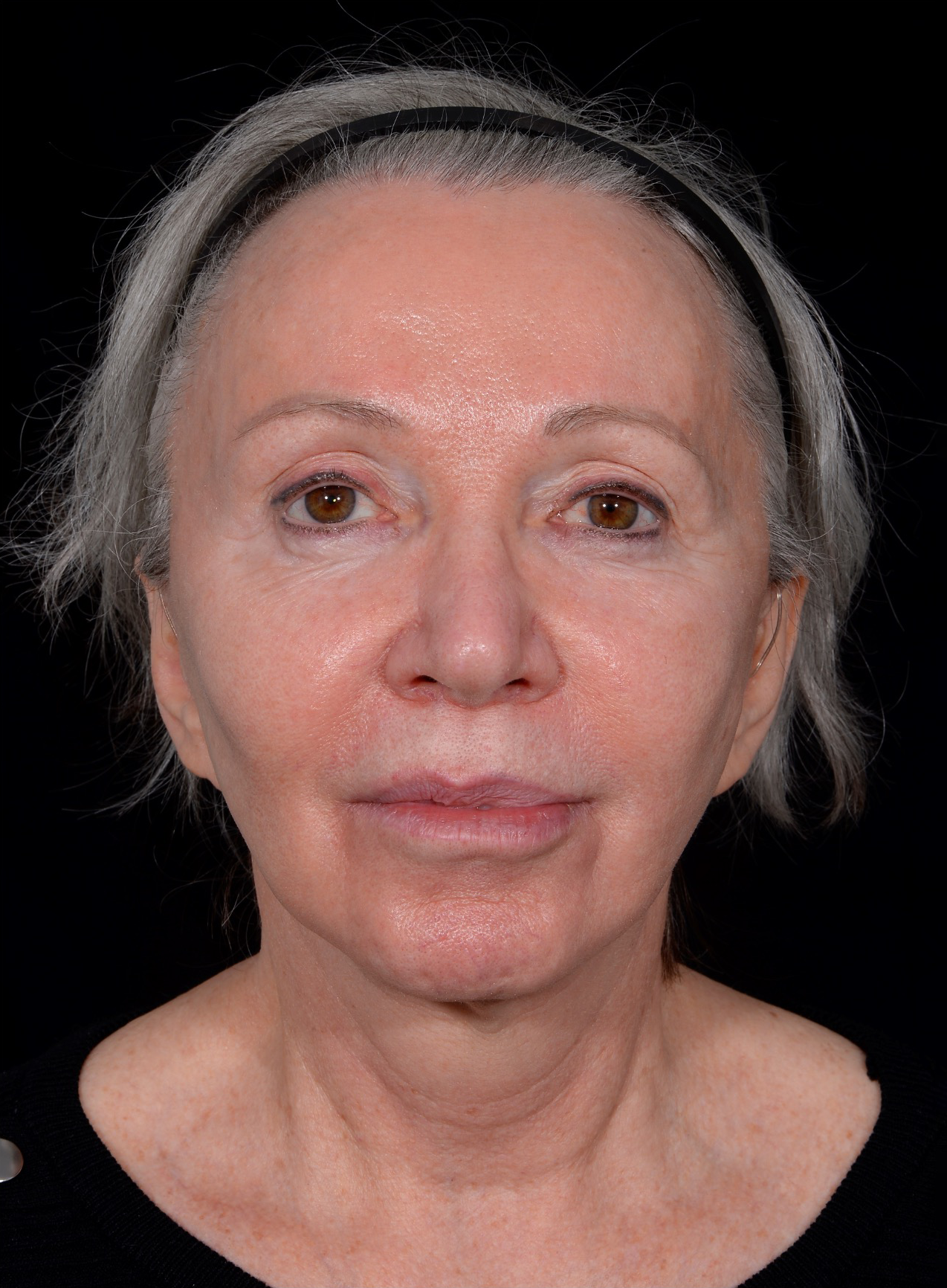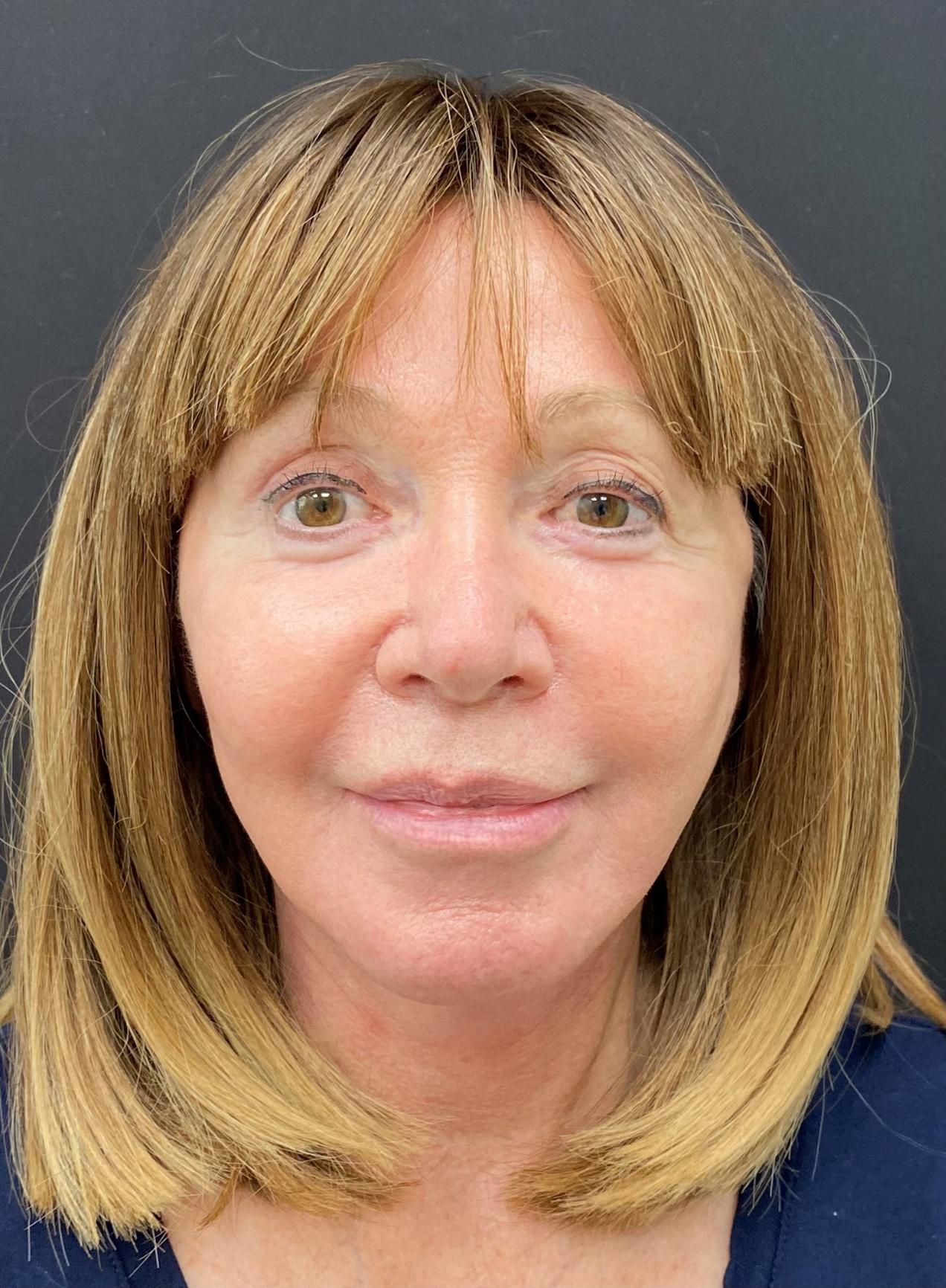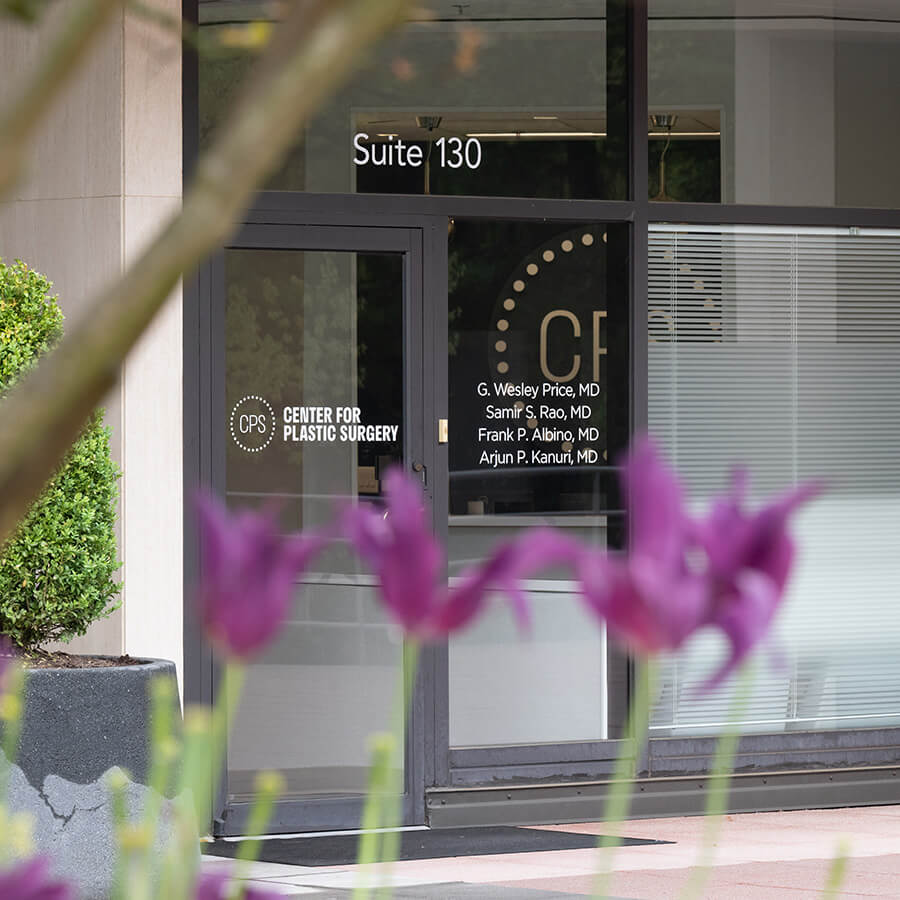All modern-day facelifts include work on the deep plane of the face. Our surgeons are comfortable and knowledgeable with the various deep plane techniques and will help you choose the right approach for your goals and anatomy. Each procedure is unique to the needs, anatomy, and goals of the patient; therefore, your consultation with one of our experienced, board-certified plastic surgeons will be useful in determining the best facelift option for you.
Facelift and Neck Lift in Washington D.C.
As a primary mode for expressing ourselves, our faces are often the center of attention. They are also constantly exposed to the elements, and this may be the first place we start to notice signs of aging or sun damage. A facelift, or rhytidectomy, is a plastic surgery procedure that eliminates loose, sagging skin around the mid-face and jawline, tightens the underlying facial muscles and tissues, and creates a revitalized, youthful facial appearance.
The board-certified plastic surgeons at Center for Plastic Surgery offer facelift surgery to help patients from Washington, DC; Chevy Chase and Bethesda, MD; Arlington and Fairfax, VA; and surrounding areas look naturally refreshed and more youthful. Known for providing some of the best facelift results, our surgeons’ facial rejuvenation expertise and case histories are unmatched by other practices in the area.


What Are the Benefits of a Facelift?
- Revitalize a tired or concerned appearance
- Create definition along the jawline and chin
- Reduce the appearance of nasolabial folds (creases from the nose to the mouth)
- Tighten loose skin and muscles throughout the face and neck
- Eliminate excess skin after weight loss
At Center for Plastic Surgery, we perform facelifts and neck lifts as one surgery. A neck lift is a surgical procedure that improves the contour of the neck by repositioning the skin and muscles. If you have significant sagging around the neck and jawline, your plastic surgeon may combine the two procedures.
Before & After Photos



Am I a Candidate for a Facelift?
While there’s no best age to undergo this procedure, the best candidates for a facelift have sagging skin around the face and neck but still have good skin elasticity and bone structure. Additionally, facelift candidates:
- Want a long-lasting solution to facial and neck aging
- Have moderate to severe skin sagging and wrinkles
- Are generally in good health
- Do not smoke or are willing to quit
- Have realistic expectations for results
What Are My Facelift Options?
Mini Facelift
A mini facelift is a less invasive procedure than a traditional facelift, with a focus on the lower-mid region of the face, treating mild to moderate facial sagging around the mouth and jawline. Occasionally, these can be performed under local anesthesia.
Candidates for a less invasive mini facelift have early facial aging and are often in their late thirties or forties. This procedure is also called a short-scar facelift because the incisions are shorter than those made for a traditional facelift. Recovery can be shorter as well. Keep in mind that the improvements from a mini facelift are more limited than what can be achieved with a traditional facelift.
Combination Facelift and Neck Lift
In most cases, we will combine a full facelift with a neck lift, as many patients will experience similar rates of aging along both the neck and face. This allows our plastic surgeons to create a more cohesive, harmonious result. Candidates for a neck lift may exhibit:
- Loose, hanging skin around the jawline and neck, sometimes called a “turkey neck”
- A lack of definition around the jaw and chin
- Neck banding

What Is a Liquid Facelift?
People who are not ready for or interested in surgery may consider a liquid facelift. This non-surgical procedure rejuvenates the face with a combination of dermal filler and BOTOX® Cosmetic injections. Below are some comparisons between a surgical facelift and a liquid facelift:
Traditional Facelift vs. Liquid Facelift Candidates
Facelift: Have moderate to advanced skin laxity and sagging tissues on the cheeks, around the mouth, and along the jawline.
Liquid Facelift: Have early signs of aging, such as mild marionette lines or nasolabial folds; volume loss around the eyes, on the cheeks, and at the temples; and wrinkles across the forehead, between the eyebrows, and at the outer corners of the eyes.
Traditional Facelift vs. Liquid Facelift Downtime and Results
Facelift: Requires about two weeks of downtime, with dramatic yet natural-looking results that last from six to ten years or more.
Liquid Facelift: Requires no downtime or recovery, with subtle results that make patients look refreshed. Results can last six months to a year.
FACE360
Not sure which option is best for you? Center for Plastic Surgery has a long history in facelifting and facial rejuvenation surgeries. We will help guide you in the best approach for your goals and anatomy and answer any questions you have during your consultation. Our FACE360 program incorporates a multimodal approach to facial rejuvenation, helping patients determine which combination of surgical, non-surgical, and non-invasive procedures will give them the ideal results for their needs. Instead of focusing on surgery, we also consider the appearance and condition of the skin when creating a treatment plan.
Some patients need more attention to surgical procedures, and some benefit from a quality, medical-grade skincare program or nonsurgical procedures such as BOTOX® Cosmetic, fillers, and resurfacing options done in our office. No other practice in the area offers such a comprehensive and detailed program.
How Is a Facelift Performed?
Your Facelift Consultation
At CPS, the consultation is a vital step in the plastic surgery process, as it gives you the opportunity to meet with one of our board-certified plastic surgeons and ask any questions you may have, discuss the risks and benefits of a facelift, and get a good idea of what you can reasonably expect from the results.
Our facial rejuvenation experts are highly trained and have decades of experience performing facelift surgeries with natural-looking yet transformational results. Our board-certified facial plastic surgeons will walk you through the facelift process and help you create a custom surgical plan that addresses all of your needs.
The pre-surgical meetings at CPS also focus on preparing you for your surgery; each member of our team–including our surgeons, nurses, and support staff–is committed to helping patients throughout their surgical process to ensure a safe and satisfactory experience.

The Facelift Procedure
Each facelift that our surgeons perform is unique to the patient, so your facelift process may look a little different than someone else’s. However, a general facelift procedure is as follows:
Your facelift will be performed either in our Virginia office’s accredited outpatient surgery suite or at a local hospital in Washington, DC, depending on which is more convenient for you. Surgery will be performed under general anesthesia or local anesthesia with sedation administered by one of our board-certified anesthesiologists.
Although most of our facelifts are performed as outpatient surgeries, some patients choose an overnight hospital stay for convenience or because they are coming from out of town. We can help arrange hotel accommodations as well as around-the-clock or overnight nursing care, depending on your wishes and needs.
Your surgeon will begin by making carefully hidden incisions behind the hairline at the temples and around the front of the ear. Through these incisions, they will reduce and reposition the deeper fatty tissues beneath the skin along the neck and jowls. The deep plane and underlying SMAS layer and facial and neck muscles are tightened, and then excess skin is removed. When the desired results are achieved and a natural contour of the face and neck has been restored, your incisions will be closed and sutured. The J-Plasma treatment may be used to smooth fine lines and wrinkles and enhance skin tightening. Fat grafting is often used to restore volume to the cheeks and nasolabial folds using your own natural tissue.
We often perform laser resurfacing or light chemical peeling at the time of facelift surgery to not only rejuvenate lax skin and tissue but also to improve the overall beauty and quality of the skin.
What Can I Expect From Facelift Recovery?
Immediately after your procedure, you will be wrapped in a turban-style surgical dressing that extends under your neck and chin. In some cases, drains may be placed during surgery. Your surgeon will provide you with specific aftercare instructions on incision care, controlling swelling, facial massage, and more.
Be sure to follow your aftercare instructions carefully, as these will help your healing process and comfort immensely. You will need to prioritize getting enough rest as you heal, but it’s also important to incorporate light movement as soon as you feel up to it, as this will reduce the risk of blood clotting.
You may be asked to avoid strenuous movement and exercise for a few weeks after your procedure. You will experience swelling and bruising, which will peak within 3 to 4 days post-op and can vary between the sides of your face. Your aftercare instructions will include things you can do to minimize swelling and bruising, including:
- Wearing your chin strap/compression wrap as directed
- Keeping your head elevated even while sleeping. You may wish to prop yourself up with pillows or sleep in a recliner.
- Applying cold compresses as directed during the first 48 hours.
- Avoid bending over at the waist, heavy lifting, and straining for the first three weeks.
- Limiting sun exposure for at least two to three months.
Facelift Recovery Timeline
Each patient will have a slightly different recovery process, as each person’s natural healing process and surgical plans will vary. A general facelift recovery timeline is as follows:
- Begin incorporating low-impact movement like walking
- Dressings and drains (if drains are used, they are removed in the first 1-2 days after surgery)
- Take a shower and wash your hair
- Return to work and nonstrenuous activities (depending on your job)
- Swelling and bruising fade
- Ready to stop wearing your compression wrap
- Patients are now often comfortable going to public places like eating out at a restaurant
- Ok to sleep on your side (when cleared)
- Resume workouts (increasing intensity gradually)
- Safe to color or perm your hair
- Numbness in the surgical area fades
- Final results
- Scars fade
How Much Does a Facelift Cost?
The cost of a facelift in Washington, D.C., depends on the details of the surgical plan, including the techniques used and the level of necessary revision, as well as the type of anesthesia used and whether you have combined procedures or not.
Center for Plastic Surgery facelifts start at a pricing range of $14,000, which includes all surgical fees, anesthesia fees, the combined neck lift, office visits, and compression wraps.
Facelift Frequently Asked Questions
Are there non-surgical alternatives to a facelift?
While no minimally invasive or non-surgical treatment can compare with the skin tightening and deep lifting results of a facelift, there are other options available for patients to enhance and maintain the results of their procedures:
Minimally invasive skin procedures such as Halo® laser skin rejuvenation, Sciton® laser skin resurfacing, and J-Plasma skin tightening can enhance the results of surgical and nonsurgical facelifts.
Will I have scars after my facelift?
Our surgeons conceal the facelift scars within the hairline and natural facial creases. The scars initially look pink and gradually turn white as they heal, eventually becoming unnoticeable. For optimal results, protect your scars by wearing high-quality sunscreen with at least SPF 15 daily. If you wear makeup, apply your sunscreen first.
Can I combine my facelift with other procedures?
Our traditional or full facelift generally incorporates a neck lift to tighten skin and vertical neck bands. However, each patient is different, so you may not need to combine your facelift with a neck lift, or you may benefit from revitalizing other areas of the face, such as the brows or under and lower eyelids.
In any case, your surgeon will work with you to determine which procedures, be they surgical or non-surgical, will best complement your facelift and provide the best results.
How long will facelift results last?
The answer is as individual as you are. While surgery can turn back the clock, it does not stop aging. Facial aging will continue at a normal rate for you. Some patients begin to consider a second facelift in 6 to 10 years, while many patients never have a second procedure.
Alternatively, facelift patients may benefit from non-surgical rejuvenation treatments to maintain their results for even longer.

A Reputation Built on Results
Interested in a Facelift in Washington, D.C.?
If you would like to learn more about how a facelift can restore your confidence and help you age with grace, fill out our online contact form or call Center for Plastic Surgery today at (301) 652-7700.